Related Research Articles

Sir George Gilbert Scott, largely known as Sir Gilbert Scott, was a prolific English Gothic Revival architect, chiefly associated with the design, building and renovation of churches and cathedrals, although he started his career as a leading designer of workhouses. Over 800 buildings were designed or altered by him.
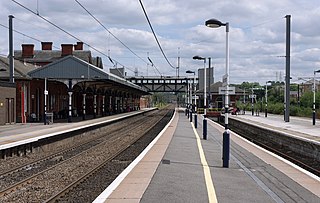
Grantham railway station is on the East Coast Main Line, serving the market town of Grantham, Lincolnshire, England. It is 105 miles 38 chains (169.7 km) down the line from London King's Cross and is situated on the main line between Peterborough to the south and Newark North Gate to the north.
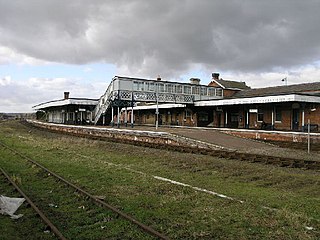
Sleaford railway station serves the town of Sleaford in Lincolnshire, England. It lies on the Peterborough–Lincoln line. The station is 21 miles (34 km) south of Lincoln Central.

Swinderby railway station serves the villages of Swinderby, North Scarle, Eagle and Morton Hall in Lincolnshire, England. The station is 8.75 miles (14 km) south west of Lincoln Central on the Nottingham to Lincoln Central Line, owned by Network Rail and managed by East Midlands Railway who provide all services.
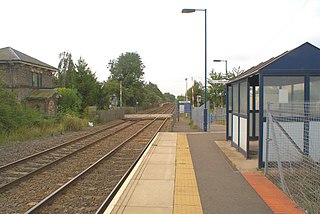
Bleasby railway station serves the village of Bleasby, Nottinghamshire, England. It is on the Nottingham to Lincoln Line, owned by Network Rail and managed by East Midlands Railway.

St Peter's Church, formally The Church of St Peter with St James, is an Anglican parish church in the city centre of Nottingham, England. It is part of the parish of All Saints', St Mary's and St Peter's, Nottingham.

St Nicholas Church, known locally as St Nic's, is an Anglican parish church in Nottingham. The church, since 1953, is Grade II* listed by the Department for Digital, Culture, Media and Sport as it is a particularly significant building of more than local interest.

Thomas Chambers Hine was an architect based in Nottingham.
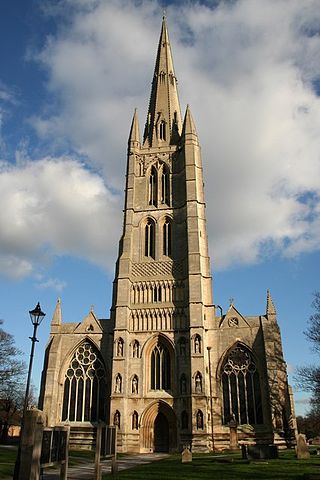
St Wulfram's Church, Grantham, is the Anglican parish church of Grantham in Lincolnshire, England. The church is a Grade I listed building and has the second tallest spire in Lincolnshire after St James' Church, Louth.
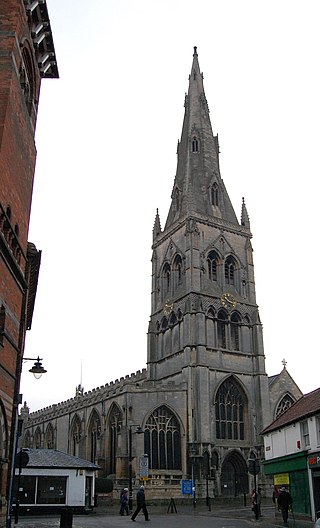
St Mary Magdalene Church, Newark-on-Trent is the parish church of Newark-on-Trent in Nottinghamshire, England. It is dedicated to Mary Magdalene and is the tallest structure in the town.

Holy Trinity Church, Lenton is a parish church in the Church of England Diocese of Southwell, located in Lenton, Nottingham.

Henry Mackenzie was Bishop of Nottingham from 1870 until 1877. He became the first suffragan bishop in the Church of England since 1608.
St. Paul's Church, George Street, was a Church of England church built as a chapel of ease to St. Mary's Church, Nottingham. It was opened in 1822 and closed in 1924.
St Mark's Church, Nottingham, was a Church of England church in Nottingham, UK, between 1856 and 1958. The section of Huntingdon Street where the church was located was formerly called Windsor Street.
Henry Oswald Hodgson FRCO was an organist and composer based in England.

Albert Nelson Bromley was an English architect based in Nottingham.

Robert Evans FRIBA, JP was an English architect based in Nottingham.
Henry Walter Wood was an English architect based in Nottingham.
George Eaton Stanger MRCSE LSA (1816-1892) was an English surgeon based in Nottingham.
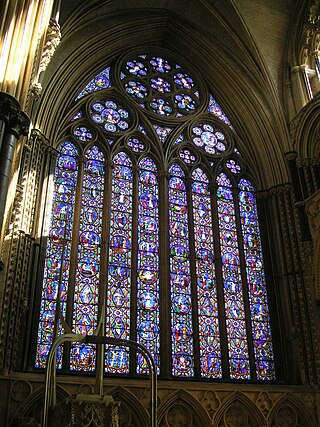
James Henry Nixon (1802–1857) was an illustrator and painter during the Victorian period, who worked in the firm Ward and Nixon painting stained glass windows. James Henry Nixon was a protégé of Charles Winston, who praised Nixon's work at Westminster Abbey and Church of Christ the King, Bloomsbury. The company Ward and Nixon was followed by Ward and Hughes.
References
- ↑ "Late Mr. F.M. Ward" . Nottingham Evening Post. England. 9 April 1914. Retrieved 1 June 2017– via British Newspaper Archive.
- ↑ "Marriages" . Lincolnshire Chronicle. England. 22 April 1853. Retrieved 1 June 2017– via British Newspaper Archive.
- ↑ "The Late Mr. F.M. Ward" . Liverpool Daily Post. England. 8 April 1914. Retrieved 1 June 2017– via British Newspaper Archive.
- ↑ "Mr. F.M. Ward" . Stamford Mercury. England. 21 July 1865. Retrieved 1 June 2017– via British Newspaper Archive.
- ↑ Humphreys, Margaret; Evans, Robert (1997). Dictionary of Composers for the Church in Great Britain and Ireland. A&C Black. p. 350. ISBN 9780720123302.